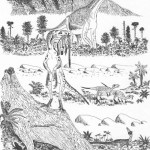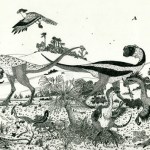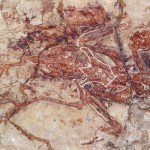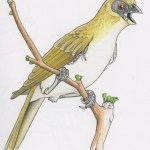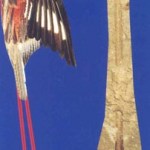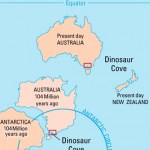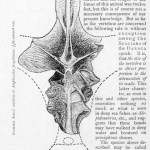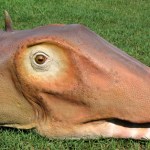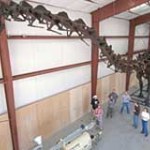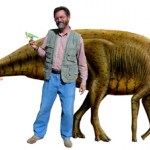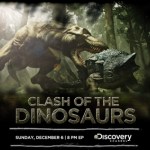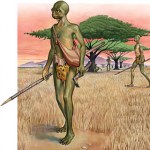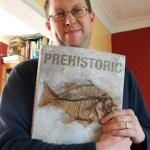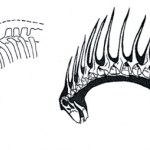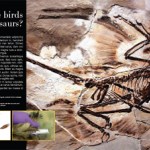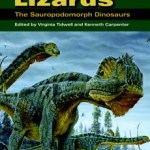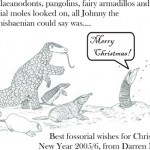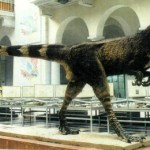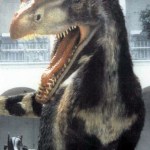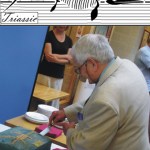Mesozoic dinosaurs
Another one. Identify the creatures (all from the Barremian Wessex Formation of the Isle of Wight, England) - possibly more difficult this time! Remember that some of the animals are in 'historic guise', so are portrayed very much inaccurately. And no cheating, as labelled versions of this picture have been published before (in the Japanese Dino Press magazine).
And sorry the image is so small: without publishing numerous close-ups, this is the only way I can get the whole image on the screen.
When I was a kid I drew lots of dinosaurs. My efforts weren't too bad, but of course I got a lot wrong (by modern standards) and - like so many dinosaur fan-boys and girls growing up in the 80s and 90s - I became a very good copier of Greg Paul. Here's a Late Cretaceous Mongolian scene I drew once (I cheated, as some of the animals shown here might never had met). Your challenge: name them.
As might be obvious, I always liked filling in all the little details. Plants, rocks, bugs and such. In fact, I always thought I might make a reasonably good mural artist: in Prehistoric Life Murals,…
Yet another entry from the fieldguide (though substantially updated and enlarged)...
What might be one of the strangest Cretaceous birds was described in 2004. I refer of course to Aberratiodontus wui of the Jiufotang Formation of Liaoning Province, China.
Named for a near-complete specimen, Aberratiodontus was regarded by its describers (Gong et al. 2004) as one of the most unusual of the enantiornithines or 'opposite birds' (though read on!). In keeping with the tradition of Linnaean taxonomy, they gave it its own eponymous 'family' and 'order' (these being 'Aberratiodontuidae' and '…
Again, more recycled text from the Mesozoic bird section of the fieldguide...
Alexornis antecedens from the Upper Cretaceous (?Campanian) La Bocana Roja Formation of Mexico was first described in 1976; its remains were discovered in 1971 by H. J. Garbani and J. Loewe. The bones they found - various elements from the shoulder, wing and leg - were tiny, and evidently from a bird similar in size to a modern finch [adjacent life restoration by Ken Kirkland, from Hilton (2003)]
This discovery pre-dated the 1981 recognition of enantiornithines as a distinct group of Mesozoic birds (see the article…
When there's no time for anything else, at least I can recycle text from the aborted field-guide (see bottom for previous excerpts). Hmm, I really should get that published. Anyway...
Protopteryx fengningensis was named in 2000 for two specimens discovered in the Yixian Formation of Fengning County, northern China [adjacent figure from Zhang & Zhou (2000): the tail feather shown in C belongs to Confuciusornis, not Protopteryx]. It's an enantiornithine about the same size as a modern starling. As is common among Cretaceous birds, it had teeth in both its premaxillae and dentaries. Its…
Tyrant dinosaurs - properly called tyrannosauroids - are most usually associated with the Late Cretaceous of North America. Of course, if you know anything about dinosaurs you'll also know that many tyrants were Asian. So, the most familiar tyrants - the big, short-armed kinds like Tyrannosaurus, Tarbosaurus, Albertosaurus and Daspletosaurus (all of which belong to the best-known tyrant clade, Tyrannosauridae) - were all animals of Laurasia, the northern landmass that split up during the Cretaceous to form North America and Eurasia [image above provided by Roger Benson; read on for…
By popular demand... it's the second part of the old, old, old (ver 1) article I wrote in 2006 on the obscure and poorly known mega-sauropod Amphicoelias fragillimus. Be sure to read part I first.
So, A. fragillimus was described in 1878 on the basis of an incomplete but enormous dorsal vertebra and the distal end of a femur [both reconstructed in the image below]. The details of these bones show that A. fragillimus was a diplodocoid, and thus related to more familiar taxa like Diplodocus and Apatosaurus. Despite its absurd size - suggesting (by comparison with other diplodocoids) a total…
Davide Bonadonna kindly sent on these pictures of a Diplodocus model he produced (with assistance provided by Simone Maganuco) during Summer 2009 for the Capellini Museum in Bologna. 2009 was the centenary year for the installation of the museum's Diplodocus carnegii replica skeleton: as I'm sure you know, it's one of eight D. carnegii casts sent around the world by steel magnate Andrew Carnegie. Why send the cast to Bologna, and not Rome, Milan, Florence, or Naples? For the answer, look at the document here.
You'll note that the model had a wide, rectangular muzzle. This is absolutely…
Hope you had a good Christmas - I did! Here's an old article from Tet Zoo ver 1, apologies if you recall it from its first airing in 2006. The article is now a bit dated - sorry about that (I've added one or two new bits).
Even if you're not an expert on dinosaurs, it's likely that you've heard - firstly - that some sauropods were rily, rily big and - secondly - that these biggest of the big included such whoppers as Seismosaurus, Supersaurus and Argentinosaurus. It's always helpful that their names are easy to remember. Recent work has not only resulted in the publication of reasonably…
Long-time readers might have noticed that I tend not to cover new dinosaur stories here at Tet Zoo. Partly this is because I like to be novel: I can't help but feel slightly disappointed when the subject I'm blogging about gets covered on a hundred other blogs and news-sites. It's also partly because dinosaurs get way too much coverage as it is: my aim here is to reflect tetrapod diversity as a whole, and not to focus on the attention-grabbing taxa alone. And I've done dinosaurs quite a lot already. So, sorry Aardonyx, Tawa, the proposal of venomosity in dromaeosaurs, and all those million…
You're being interviewed for a TV documentary, and that documentary will focus on your special area of expertise. For the purposes of this article, let's pretend that you're an expert on sauropod dinosaurs. While being interviewed, you're asked about the possible function of a peculiar and enigmatic structure: the cavernous expansion present in the sauropod sacral region. As everyone knows, the idea that the sacral expansion might have functioned as a sort of 'second brain' was once mooted in the literature, and - because it was a fun idea that jived well with the well-known fact that…
Regular readers will know that I'm not exactly a fan of the idea - discussed here and there in the technical (Russell & Séguin 1982, Russell 1987), popular (Hecht 2007, Socha 2008, Naish 2008) and speculative literature (McLoughlin 1984, Magee 1993) - that non-avian theropod dinosaurs might have evolved into humanoids had they not bought the farm 65 million years ago [image below by Matt Collins].
The hypothetical (emphasis: hypothetical) evolution of big brains, intelligence and so on among imaginary post-Cretaceous deinonychosaurs is not (in my opinion) all that unreasonable, and I…
Regular readers will know that my new book, The Great Dinosaur Discoveries (A & C Black in UK; UCP in US), was released over the last few weeks. By all accounts, it's currently selling well and the reviews that have appeared so far have all been outstandingly positive [example]. Things are looking good. But I work hard, and over the last couple of weeks I've received the news that a second book I completed at about the same time is also now out. Today I received my copy, so can at last talk about it.
Titled Prehistoric here in the UK (and Prehistoric Life in North America), the book is…
For the full story on all of this, you'll have to nip over to SV-POW! I guarantee you won't regret it. My favourite 'fact' about potto neck spines: they demonstrate a link with the Chupacabras (no, I don't accept this, but some do take it seriously, apparently).
Observant readers will have noticed problems with Tet Zoo's format over the last few days. This now seems to be sorted, but an unfortunate result is that what's known as my Free Module is now gone. This is the region of the sidebar that had the book adverts and links, web counter, awards, endorsements, paypal icon etc. Bummer. Trying…
I am reliably informed that a book I wrote during 2008 - The Great Dinosaur Discoveries (A & C Black, 2009) - is now out and available in the shops.
If you like my stuff you will, hopefully, want to own a copy: it's high quality, very nicely illustrated, and not all that expensive. While dinosaur books are typically arranged in either phylogenetic or geological fashion, my aim with The Great Dinosaur Discoveries was to show how our knowledge and understanding of dinosaurs has itself evolved over the decades. This sort of thing has only really been done a few times before. Ned Colbert…
Once again I'm going to recycle an old book review, sorry about that. Have had no internet access at home for the last few days, so things have been difficult here, to say the least (like so many people, I now rely on constant daily internet access for work). Anyway, find below my review of Tidwell & Carpenter's Thunder-Lizards book. The review was published in 2006 so is now rather dated. I haven't changed the text, but please note the following; a full technical paper addressing the neck posture stuff discussed below has since been published (Taylor et al. 2009); titanosaurs no longer…
I'm somewhat pushed for time at the moment (massive, massive understatement), so nothing new here, sorry. Too busy with book jobs, SVP preparation, demolition work, baby care and other stuff. So here's some nonsense: if you've been with me from the start you'll remember this captivating image from January 2006. To the rest of you it might be new. Believe it or don't it's Fig. 2 in the Tet Zoo book (currently nearing completion, after a hiatus of more than a year).
In other news: the thing everyone's talking about today is the launch of the Open Dinosaur Project. This ambitious project aims,…
In 1997, Polish palaeontologist Gerard GierliÅski worked together with artist Marta Szubert to create the amazing furry green(ish), life-sized Dilophosaurus model you see here (and below), nicknamed Dyzio. It was displayed at the Polish Geological Institute's Geological Museum at Warsaw and, while much discussed in the Polish media, is poorly known internationally.
Yes, there are a few inaccuracies (the hands are palms-down, rather than shown with the inwards-facing palms that are more correct), but overall it's a pretty neat looking model, and it's also bold and daring. What led Dr…
Yes, yes there are.
Stay tuned, all will be revealed. And if you know what this is all about, and where it went and how it ended up and so on, please don't spoil it for everyone else. Yet.
I promised myself back in 2007 that I'd cut down on the number of conferences I attend. There's a problem with that: I'm pretty bad at keeping promises (at least, to myself). This year I'm attending a ridiculous four conferences, and I've just returned from the first of them (please remind me why I have no money, and no spare time). Entitled Sea Dragons of Avalon: the early radiations of the marine reptiles and recovery from the Triassic-Jurassic faunal crisis, with special reference to Street in Somerset and the wider British record, this Palaeontological Association (Pal Ass) seminar…
